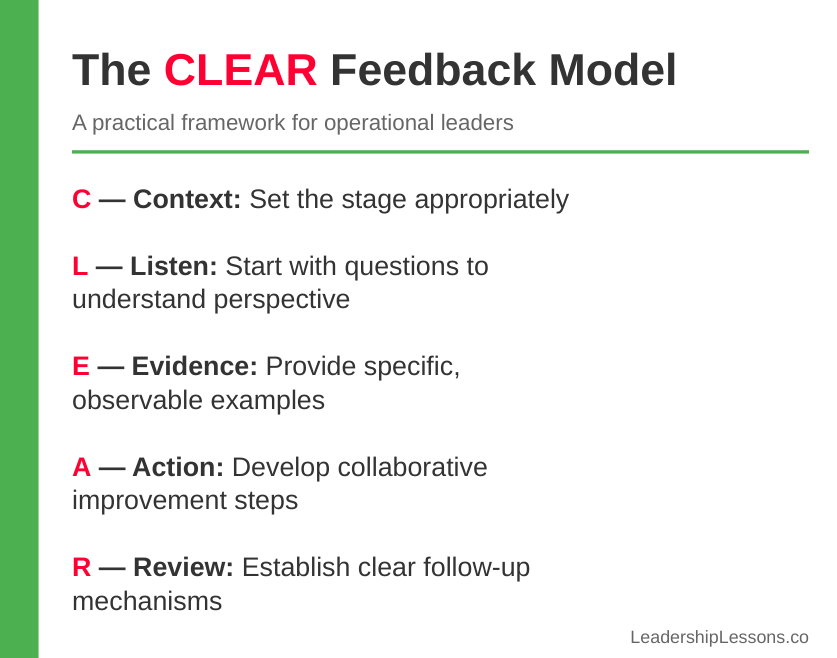This framework provides a structured approach to planning, delivering, and following up on feedback conversations in manufacturing and warehouse environments. Use it to prepare for both routine and challenging feedback situations.
PREPARATION PHASE
Context Analysis
Performance Data: What specific metrics or observations will you reference?
Example: Quality metrics, production rates, safety observations
Timing Considerations: When is the optimal time for this conversation?
Consider: Shift timing, workload, employee energy level
Location Planning: Where will the conversation take place?
Consider: Privacy needs, noise level, comfort
Expected Duration: How much time will you allocate?
Typically: 5-15 minutes for routine feedback, 15-30 for more significant issues
Self-Check Questions
What is my emotional state regarding this situation?
Am I clear on the specific behavior or outcome I want to address?
What assumptions might I be making that I should verify?
What is my goal for this conversation?
CONVERSATION STRUCTURE
Opening (Setting the Stage)
Connection: Brief personal check-in
Example: "How has your shift been going so far?"
Purpose: Clear statement of conversation purpose
Example: "I'd like to talk about what I observed during yesterday's changeover."
Tone Setting: Statement that establishes constructive intent
Example: "My goal is to help ensure we're all working safely and efficiently."
Listening Phase (Start with Questions)
Perspective Questions: (Select 2-3 appropriate to the situation)
"Can you walk me through how you're approaching this process?"
"What challenges are you experiencing with this task/procedure?"
"From your perspective, what factors are affecting your performance in this area?"
"What do you think is working well, and what could be improved?"
"What resources or support would help you in this situation?"
"How do you feel about your progress with this skill/task?"
Active Listening Checklist:
Give full attention (no phone, radio, or distractions)
Take notes if appropriate
Ask follow-up questions for clarity
Summarize what you heard before moving on
Evidence Phase (Provide Specific Observations)
Behavior Description: Specific, observable behavior without judgment
Template: "I noticed [specific observation] at [time/date/situation]."
Impact Statement: Clear description of the effect
Template: "This resulted in [specific outcome/consequence]."
Standard Reference: Connection to expectations
Template: "Our standard/expectation is [specific benchmark]."
Action Phase (Develop Improvement Steps)
Collaborative Planning: Questions to engage the employee
Examples:
"What do you think would help improve this situation?"
"How could we approach this differently next time?"
"What specific steps would make the biggest difference?"
Clear Agreement: Specific improvement actions
Template: "Based on our discussion, you'll [specific action] by [specific timeframe]."
Support Commitment: Specific assistance you'll provide
Template: "To support you, I'll [specific resource/action/follow-up]."
Review Phase (Establish Follow-Up)
Next Check-In: Specific time/date for follow-up
Example: "Let's check progress next Tuesday during your shift."
Success Metrics: How improvement will be measured
Example: "We'll know this is working when we see [specific outcome]."
Documentation Plan: How the conversation will be recorded
Example: "I'll note our discussion in the feedback log and send you a quick summary."
Positive Reinforcement: End on an encouraging note
Example: "I'm confident you'll make good progress with this."
FOLLOW-UP SYSTEM
Progress Tracking
Date of Initial Feedback: _________________
Key Action Items:
Employee Commitments: _________________
Manager Commitments: _________________
Follow-up Date 1: _______ Outcome: _______
Follow-up Date 2: _______ Outcome: _______
Resolution Date: _______ Result: _______
Reflection Questions (Complete after resolution)
What went well in this feedback process?
What could I improve in future feedback conversations?
Were there any unexpected outcomes or insights?
Is there a system/process issue that needs addressing?
Should this feedback be shared more broadly (in anonymized form)?
SPECIAL SITUATION GUIDELINES
For Performance Issues
Document specific examples with dates and metrics
Connect to broader business impact
Develop detailed improvement plan with clear milestones
Follow company documentation requirements
Consider involving HR for serious performance concerns
For Sensitive Personal Matters
Ensure complete privacy
Begin with positive acknowledgment
Use a bridge phrase: "I need to discuss something personal that's difficult to talk about"
Focus on workplace impact rather than personal judgment
Offer appropriate support resources
End with reassurance of value
For Cross-Cultural Considerations
Research cultural norms if possible
Be explicit about intentions
Focus on concrete behaviors and outcomes
Adjust directness as appropriate
Ask about preferred feedback style
Watch for non-verbal cues of discomfort
Quick Reference: The CLEAR Feedback Model
Downloadable from www.LeadershipLessons.co

